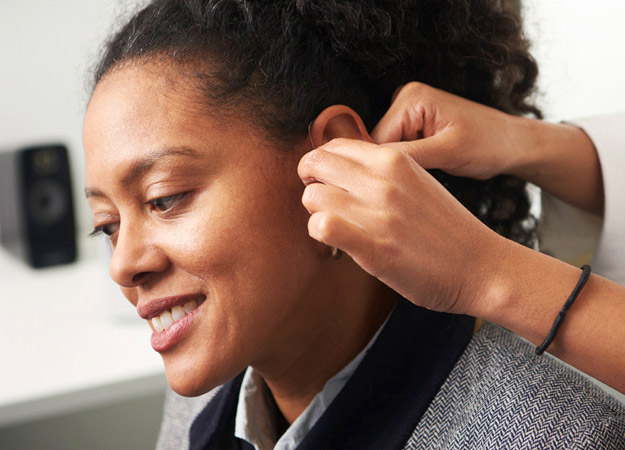Ask yourself: Do you need a hearing test?
Answer the four questions below to see if you should consider getting a hearing test.
The symptoms of hearing loss depend on the type, degree and cause of hearing loss.
If you recognize any of the below symptoms, we recommend getting a free hearing test at a hearing clinic near you.
If you or someone you know can relate to any of the signs of hearing loss listed above, then it may be an indication of hearing impairment, and you should get your hearing tested.

Answer the four questions below to see if you should consider getting a hearing test.
Your answers indicate that you experience symptoms of hearing loss. We strongly recommend booking a hearing test at one of our clinics.
The result is an indication. An in-person hearing test can determine if you have a hearing loss.
Your answers indicate that you experience some symptoms of hearing loss. We recommend booking a hearing test at one of our clinics.
The result is an indication. An in-person hearing test can determine if you have a hearing loss.
Your answers do not indicate that you experience symptoms of hearing loss. However, if you experience trouble hearing, we recommend booking a hearing test at one of our clinics.
The result is an indication. An in-person hearing test can determine if you have a hearing loss.
The degree of hearing loss refers to the severity of the loss and is generally categorized as either mild, moderate, severe, or profound.
It can be measured in decibels (dB), referring to how loud sounds need to be for you to hear them.
Sensorineural hearing loss
The most common type of hearing loss is called sensorineural hearing loss. It can be caused by damage to tiny hair-like cells in the inner ear or damage to the auditory nerve. Often, this type of hearing loss can be treated with hearing aids.
Understanding the Causes, Symptoms, and Treatment
Sensorineural hearing loss is a common type of hearing loss
that can lead to permanent hearing loss. It occurs when there is damage to the
inner ear or the auditory nerve, often resulting from age-related changes, ear
diseases, noise-induced hearing loss, head injury, and infections. Presbycusis,
or age-related hearing loss, is a common cause of sensorineural hearing loss,
as the delicate hair cells in the inner ear can degenerate over time. Exposure
to loud noise can also cause sensorineural hearing loss by damaging the hair
cells or auditory nerve.
The symptoms of sensorineural hearing loss include difficulty hearing soft sounds, trouble understanding speech, tinnitus (hissing sounds in the ears), and a feeling of fullness or pressure in the ears. If left untreated, sensorineural hearing loss can progress and lead to further hearing problems and even permanent hearing loss.
There are different types of hearing loss including sensorineural hearing loss (damage to the inner ear), conductive hearing loss (damage to the outer and/or middle ear) and mixed hearing loss (damage to the inner ear and outer and/or middle ear). Hearing aids are the most common form of treatment, as they can amplify sounds and improve hearing ability. Cochlear implants are another option for individuals with severe hearing loss, as they can bypass damaged hair cells and stimulate the auditory nerve directly.
Conductive hearing loss
This type of hearing loss comes from a mechanical problem in the middle or outer part of the ear. Conductive hearing loss can also be caused by an obstruction of some sort in the canal of the ear, such as earwax preventing sound from getting to the ear drum. It can be treated using hearing aids or other medical options.
Mixed hearing loss
Mixed hearing loss is when both aspects of sensorineural and conductive hearing loss are present.
Hearing loss is more common than you might think.
Understanding the source of your hearing issues gives our professionals insight into your needs, so we can advise you with the best options for your specific treatment. That's why we encourage you to speak with our professionals as soon as you notice any hearing difficulties.
If you are looking for treatment for hearing impairment, we advice you to begin the process as soon as possible.
This is key to improving your quality of life, so that you can enjoy your favourite activities again – such as engaging in conversations with friends and family or watching your favourite TV show again.

Hearing loss treatments include: ear wax removal, hearing aids, surgery, cochlear implants or bone anchored hearing solutions.
The best solution for your hearing loss will depend on:
Hearing aids are essential tools for managing hearing loss and can provide several benefits, including improved communication, increased social engagement, and better quality of life. By addressing hearing loss with hearing aids, individuals can experience significant improvements in their overall well-being and lead active, fulfilling lives.
When selecting hearing aids, several factors should be considered to ensure they meet the individual's specific needs and preferences. The type and severity of hearing loss, lifestyle and personal preferences, budget, compatibility with other devices, and fit and comfort are all important factors to consider.
Better communication is one of the most significant positive impacts of hearing aids for individuals with hearing loss. Hearing aids can help individuals hear and understand speech and sounds more clearly, leading to more effective communication with family, friends, and colleagues. With improved communication, individuals can feel more confident in social settings, leading to increased social engagement and participation in activities they may have previously avoided due to hearing difficulties.
In addition to better communication and increased social engagement, addressing hearing loss with hearing aids can lead to enhanced overall well-being. It can reduce feelings of stress, anxiety, and depression associated with hearing difficulties. It can also lead to improved cognitive function and overall brain health.
To ensure that you find the hearing aid that best suits your needs, we recommend that you consult with one of our hearing professionals. Book a free 30-day trial at HearingLife to find the right device for your needs and take the first step towards better hearing.
Watch the video and hear our audiologist Timothy Humpidge explain what to expect when you visit a hearing clinic and receive a hearing test.
|
Audio |
Visual |
|
You lose your hearing without noticing it. |
White screen with text: What happens at the clinic.
From booking an appointment to getting a hearing aid |
|
So, no one is telling you that you are losing it. You do not know what you cannot hear. So, my job is trying to help them through that process, make them feel comfortable. Do not make them feel like there is something medically wrong with them and make them understand that they are the same as everyone else around them, but they have made the right decision to come and talk to a professional and get the right advice |
Zoom in: the audiologist is sitting in the clinic and talking. |
|
They come down and they are welcomed. We have some amazing branch coordinators and receptionists. |
Elderly couple entering an Audika clinic and being welcomed by a receptionist. |
|
I do not want them to feel like they are going into the dentist surgery or something that is scary. This is not a scary process; this is just a way of understanding what is going on with you. People are suddenly becoming aware that hearing loss is normal and natural. So, what do I do about it? I go and see someone in Audika |
The woman checks in for her appointment at the reception and is guided into the waiting room. |
|
And then I hope when they meet me for the first time, they feel “oh, that is not too scary.” |
The audiologist greets the client and spouse and shows them to his office. |
|
And I then make a big job of making them feel comfortable with me and settle them down. I do not leap in and start putting stuff into their ears, but I talk to them and get to know them |
Close up clip of the audiologist sitting in the clinic and talking. |
|
I then try to explain what I am going to do. Firstly, just checking their general health because that is very important as well. Poor health will have an effect on your hearing. |
The audiologist is checking the client’s medical records on a tablet. |
|
I then basically explain how your hearing works. Remembering very simply that the ears are a transportation system |
The audiologist uses a model of an ear to explain how we hear. |
|
So, we go through checking that their ears are doing their job. And then in that process I will get some pointers to where I need to look a little bit more thoroughly |
The audiologist checks the client’s ear. |
|
And then we will do a slightly more scientific test, just to check each ear individually and see what the brain is hearing independently |
The audiologist performs a hearing test to check the client’s hearing.
|
|
At that point I then graphically explain it to them. This is what your hearing is and why you are not hearing whatever you have explained. So, it is a very simple picture for them to look at and think “ah, yes of course that makes sense.” |
The audiologist explains graphical findings on the hearing tests. |
|
And we can then talk about the solution that fits that particular need |
The audiologist presents various hearing aids to the client. |
|
I will demonstrate the hearing aids to them. Give them the chance to compare before and after. So, we do a little word test. How you are hearing before, how you are hearing after. And the gain that comes from the spouse being there because that is the most crucial voice.
|
The client is fitted with a pair of hearing aids and engages in a conversation with the audiologist and the spouse. |
|
And at that point they can make that informed decision: Yes, that is going to make massive changes to my life.
You put it in your years, wear it all day, every day without fail. Your brain will become retrained and you will start to hear better. That is all we need to worry about. What we will do is to see you regularly in the future. Service them, check that they are working. If at any point you have a problem or are noticing a change in your hearing, you come straight back to us and we find out why it did.
The testing of your hearing is vital because it gives a benchmark of where you are today, and we will test it again in the future. So, if there is a change naturally in your hearing, which there will be, we can see that and reprogram the hearing aids, so they become a long-term solution to your problem and something you do not have to worry about. |
Close up clip of the audiologist sitting in the clinic and talking |
|
There is really no need for button pressing nor controlling them anymore. They do it all for you. They adapt. But we are there if you need us. |
The audiologist shows the client out of the clinic. |
|
Music |
The elderly couple walks out of the clinic into the street. |
|
Music |
Audika logo
Book a free hearing test today. |

While there is no cure for loss of hearing, there are steps you can take to prevent it and reduce your chances of developing hearing loss over the course of your lifetime.
Learn more about healthy hearing practices and protection solutions that can help keep hearing loss at bay.
1. Kochkin, Sergei (2009) ”MarkeTrak VIII: 25-Year Trends in the Hearing Health Market” The Hearing Review, vol. 16, no. 11.
2. McCormack, A. & Fortnum, H. Why do people fitted with hearing aids not wear them? Int J Audiol. 2013 May; 52(5): 360–368.
3. Chisolm, T. H., Johnson, C. E., Danhauer, J. L., Portz, L. J. P., Abrams, H. B., Lesner, S., … Newman, C. W. (2007). A
systematic review of health-related quality of life and hearing aids: Final report of the American Academy of Audiology Task
Force on the Health-Related Quality of Life Benefits of Amplification in Adults. Journal of the American Academy of Audiology,
18(2), 151-183
4. Masterson EA, Bushnell PT, Themann CL, Morata TC. Hearing Impairment Among Noise-Exposed Workers — United States, 2003–2012. MMWR Morb Mortal Wkly Rep 2016;65:389–394. DOI: http://dx.doi.org/10.15585/mmwr.mm6515a2
5. Haile et al. Hearing loss prevalence and years lived with disability, 1990–2019: findings from the Global Burden of Disease Study 2019. The Lancet. 2021 March. https://doi.org/10.1016/S0140-6736(21)00516-X